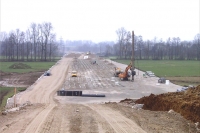Linz - Selzthal Railway Line,
Schlierbach By-Pass Section
Client: Austrian Railways Infrastructure Construction AG
Development Period: 1994 to 2005
In the section, between the 45.1 and the 49.6 km mark, of the Linz - Selzthal railway line (Pyhrn Railway Line), the city of Schlierbach had to be by-passed on the western side. By straightening the route, the travel speed was increased, while the route length was decreased. Simultaneously, the line was upgraded into two tracks in accordance with the standards of a high-performance line.
In this section, high embankments had to be built or extended. Further, the project also included the restructuring or rebuilding of six bridges and numerous pipe crossings.
BGG was commissioned with the geotechnical and hydrogeological consulting during all design and construction phases. Consequently, two phases of subsoil exploration were carried out. Further, BGG assisted with the planning, coordination and evaluation of the tender procedure (phases of route determination and tender planning). In this project, the construction schedule was significantly influenced by numerous geotechnical measures (embankment built-up in stages, soil improvement measures). Consequently, during the whole design phase, it was especially important for the intensive and early involvement of a geotechnical specialist.
During construction, BGG conducted the geotechnical and hydrogeological consulting on site.
Soil improvement measures:
The newly built section of the by-pass crosses over an area with very disadvantageous subsoil conditions. Furthermore, embankments (with a height of up to 8 m) and bridges had to be built in this area. The bad quality of the underground results from peat layers and especially from lacustrine clay layers.
Thus it was of great importance that the foundations of the dams and bridges be technically sufficient. For the critical sections, BGG recommended the placement of vertical drains up to a depth of 25 m with a triangular pattern of 1,5 m x 1,5 m. Furthermore, in order to prevent long lasting settlements, it was necessary to place an overload fill (2 m above rail level). Because the overload fill was also placed across the areas of the bridges, it was possible to forestall the settlements of the structures. This made it possible to change the originally planned deep foundation to a shallow foundation.
July 2005
